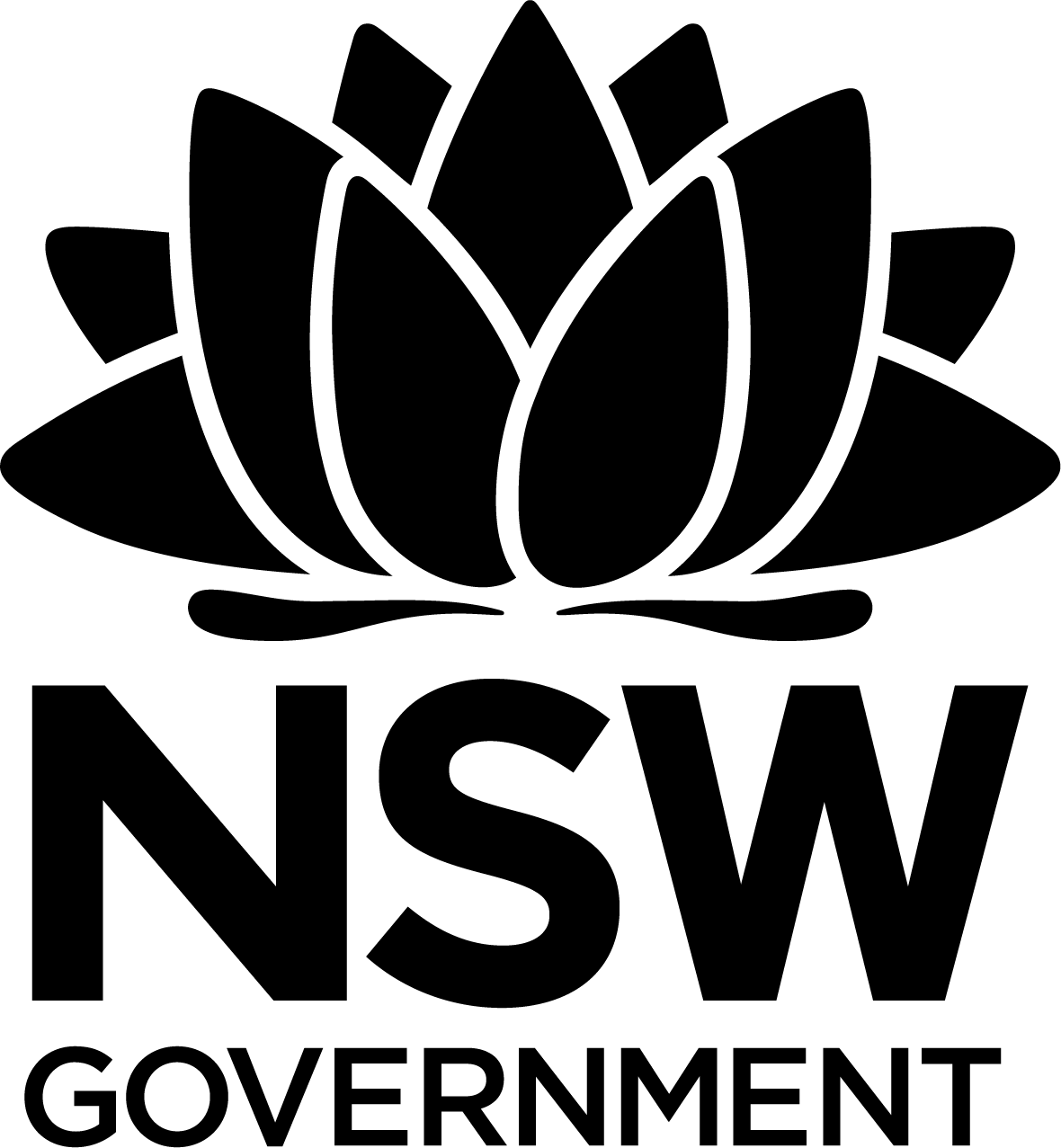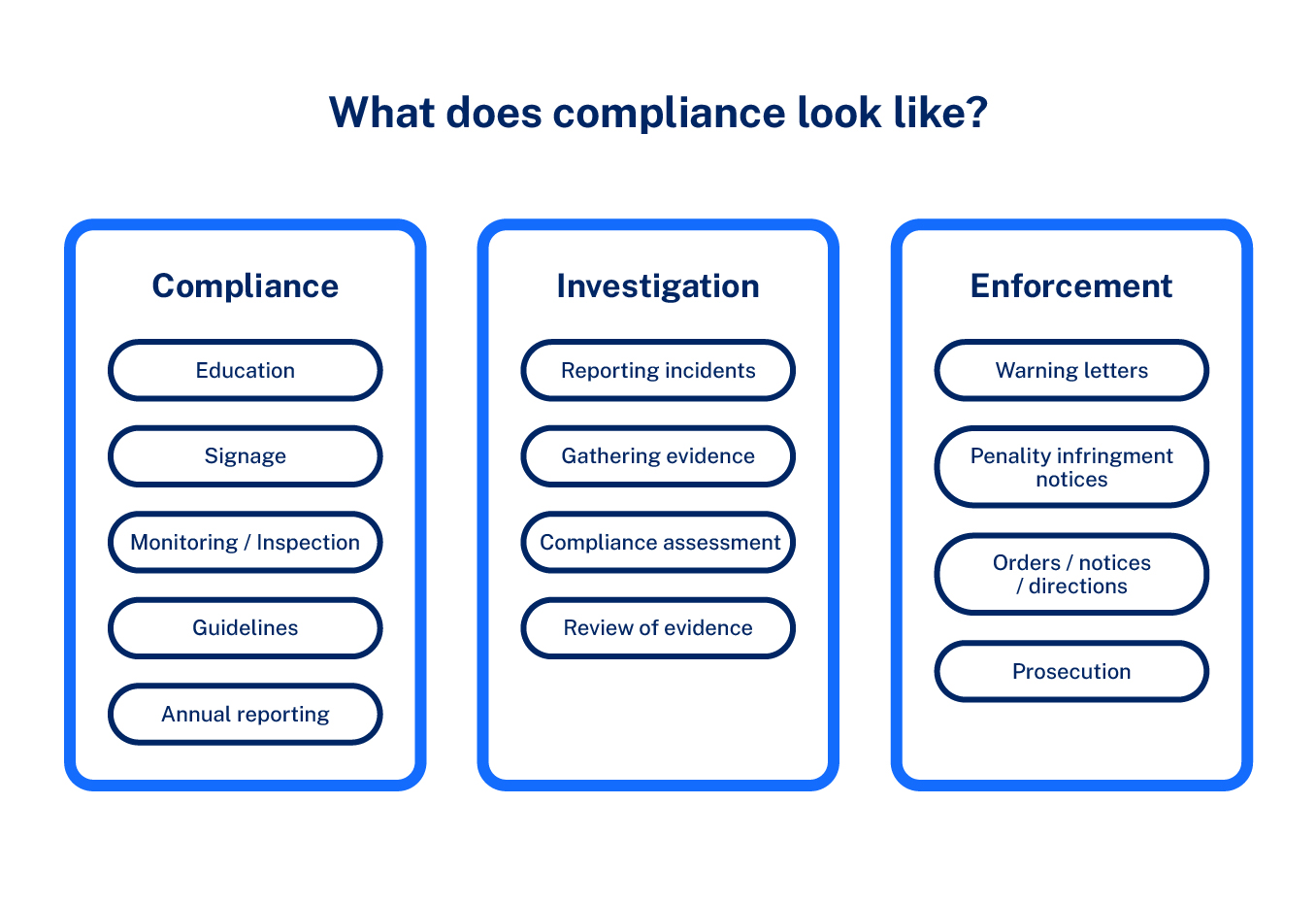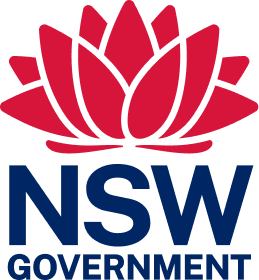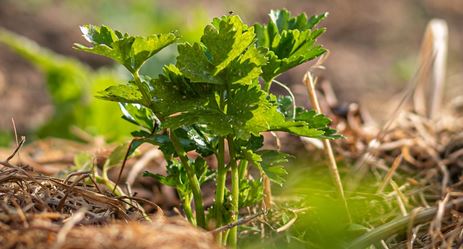
Crown land manager resource
Compliance matters
Compliance and enforcement
A Crown land manager (CLM) is the name for a body that cares for, controls and manages Crown reserves on behalf of the people of NSW (Section 3.13, Crown Land Management Act 2016, Functions of Crown land managers).
This means that appointed CLMs have both the authority and the obligation to exercise all required administrative functions where they relate to land management and use of the reserves.
Land-management activities:
- ensure that use and activities are consistent and compatible with the reserves’ purpose
- are in both the public’s and the environment’s best interest
- comply with relevant state legislative requirements.
What is regulatory compliance?
As it relates to Crown land, regulatory compliance includes a range of processes, procedures and actions that help ensure the sound application of Crown land legislation to meet our land-management responsibilities. It incorporates the efforts of administrators to ensure that the public is aware of relevant laws, policies and regulations relating to the appropriate use of the Crown reserve.
Crown land legislation provides CLMs with specific functions to support the successful care, control and management of Crown land and allows controls to be put in place to achieve this. CLMs have a duty to ensure visitors to reserves are aware of and follow any CLM regulations, imposed restrictions and permitted reserve activities that support compliance to legislation.
What does compliance look like?

CLMs are not expected to formally investigate or enforce actions in their role as a land manager. But they are expected to make sure visitors and other users of Crown reserves behave in a way that preserves the environment and ensures public safety and enjoyment for all those using the reserves.
Useful methods for promoting visitor compliance and supporting effective reserve administration include encouraging voluntary compliance through education and awareness practices and clear signage.
Read on for more information and practical advice on how CLMs can meet their responsibilities and ensure that visitors to reserves comply with any CLM-imposed restrictions.
Restrictions on Crown reserves
Visitor access and use of Crown reserves should be consistent with the reserve purpose and should align with the principles of Crown land management.
Under the provisions of the Act, CLMs can protect Crown reserves from wilful damage, pollution, contamination and unauthorised use. This may include incidents where certain activities are prohibited on Crown reserves, such as:
- residing/camping
- building structures
- grazing stock
- driving or parking vehicles
- dumping of rubbish and other materials.
Under provisions of the Crown Land Management Regulation 2018 (Regulation), CLMs can restrict visitor access and use if necessary to ensure compliance with Crown land legislation. CLMs have the authority to impose restrictions to protect Crown reserves from improper use and damage. As a CLM, you can control and restrict visitor activities on your reserve by such means as:
- prohibiting visitors from certain activities on your reserve, as per the Regulation
- restricting access to parts of the reserve
- closing part or all of the land—or any structure or enclosure in or on the land—to the public (but only temporarily or periodically if the land is meant for public recreation).
Types of restrictions under the Regulation
Common restrictions in the Regulation include preventing or prohibiting visitors from the following activities if appropriate to effectively manage the reserve:
- accessing part or all of the reserve
- accessing reserve buildings
- camping without authority (a permit)
- removing timber or firewood
- driving, parking, motorcycling or four-wheel driving
- lighting fires and bonfires
- bringing animals, such as horses or dogs, onto the reserve
- selling items or engaging in commercial activities
- erecting signs or advertising.
Additionally, CLMs may manage use and access of the reserve by:
- charging entry fees
- setting opening and closing times for the reserve
- setting aside parts of the reserve for certain uses
- charging fees for activities such as parking and utility use (electricity, gas and water)
- charging fees for rubbish disposal
- designating entry and exit points.
What to consider before restricting visitor access or use
Before putting restrictions in place, CLMs should consider:
- the purpose of the restriction and constructive outcomes
- the gazetted purpose of the reserve
- the public interest
- the location of a notice or sign to promote restrictions
- compliance options if people violate restrictions.
Encouraging compliance to restrictions
CLMs have a responsibility to promote compliance with any restrictions . They should encourage voluntary compliance and positive behavioural change using various prevention tools, such as:
- clearly displaying signage and notices of expected behaviours and permitted use
- conducting reserve and activity-relevant education programs
- distributing fact sheets, brochures and reserve guidelines
- being visible on the reserve; in some situations, uniforms or clothing that identifies management may be appropriate
- undergoing training for themselves, staff and volunteers regarding reserve restrictions and compliance
- developing and maintaining good relationships with local council, rangers and police (a police or ranger visit at planned strategic times is an excellent deterrent).
Using signage and notices – what is required
The Act and Regulation require CLMs to put up signs or public notices if they want to restrict particular visitor activities or access to the reserve that can also provide for a penalty if contravened. Appropriate and clear signage helps inform the community and visitors about what they can and cannot do in the reserve.
CLMs must display relevant regulatory signage and notices in an easy-to-see and prominent place on or near the Crown land (or at a common access point to the land). For example, CLMs should place a sign telling visitors that certain activities are prohibited, such as camping or removing timber, in a highly visible area for visitors entering the reserve.
Clear signage can help increase community awareness, promote voluntary compliance and reduce the number of incidents of noncompliance with restrictions. Additionally, in cases of repeated restriction breaches, clear and prominent signage is essential to facilitate enforcement action.
Assistance in preparing signage
The department has detailed guidance on developing signage and notices, including templates. Find out more.
Responding to restriction violations
CLMs can take positive actions to manage visitors who do not comply with restrictions and should first encourage voluntary compliance. These actions may include approaching visitors to educate them about the restriction and directing them to the sign or notice (or any other available written material) about the restriction. CLMs should approach visitors only when it is safe to do so. If visitor behaviour threatens the personal safety of CLMs, they should follow CLM Health and Safety advice and contact the police.
CLMs can also manage minor restriction breaches. In most situations, CLMs’ first response to a visitor breaching a restriction should be to educate the visitor and, if necessary, the wider local community about what they can and cannot do on the reserve. If a visitor continues to breach a restriction after a CLM has attempted to inform the visitor about the restriction, the CLM may wish to contact local council staff rangers or the police.
Where noncompliance is ongoing and the police or local council cannot provide adequate support, the CLM may contact the department for assistance. In these circumstances, CLMs have a duty to help department staff, including authorised officers, with their investigation. This may include providing information and records in a timely manner or providing an accurate account of the incident. CLMs should keep adequate records and any other evidence they can collect to help with any ongoing investigation.
Optical surveillance device
Installing an optical surveillance device, such as closed-circuit television (CCTV), may be an option for CLMs who see repeated noncompliance activities, such as dumping or timber removal. The department may be able to help with both the technical requirements and the legal responsibilities if you are planning to install such devices. For example, an optical surveillance device must not have the capability to record noise (conversation). Legal obligations ultimately lie with the CLM installing such devices for compliance purposes. They need to be familiar with provisions under the Surveillance Devices Act 2007, Privacy and Personal Information Protection Act 1998 and Workplace Surveillance Act 2005.
CLMs should notify the department when they propose surveillance devices on Crown reserves. Use our contact us page with the following information:
- rationale (must be for a compliance purpose) for installing the surveillance device
- date of installation
- location
- number of devices installed
Illegal dumping
Illegal dumping is the disposal of waste larger than litter on land or in water without the correct approvals. Illegal dumping creates environmental, social and financial burdens on the land on which it is dumped.
The Environment Protection Authority (EPA) NSW Illegal Dumping Strategy 2017–21 aims to address issues through continued collaboration with the EPA's partners, local government, land managers, community organisations and industry. The strategy coordinates action on education, enforcement and infrastructure to prevent people from dumping illegally. It also outlines strong actions against those who persist in doing the wrong thing.
If you find illegal dumping, such as used household items, old tyres, green waste or construction waste (bricks and timber), within your Crown reserve or in NSW generally, you should report it through the EPA’s Report Illegal Dumping Online webpage.
Urgent response to illegal dumping
If dumped waste poses an immediate environmental risk, contact:
- council for small urgent incidents (less than two trailer loads)
- the EPA Environment Line on 131 555 for large urgent incidents (more than two trailer loads).
Emergency incidents
If there is an immediate emergency, such as toxic fumes or a large chemical spill, call 000 immediately.
Authorised officers or rangers
Section 10.6 of the Act provides that the minister may, in writing, appoint a specified qualified person to be an authorised officer. An employee of a CLM of dedicated or reserved Crown land is prescribed as a qualified person. Appointed authorised officers hold statutory functions under the Act that provide greater compliance and enforcement powers, including the ability to issue penalty notices.
In specific circumstances, CLMs may request that an employee is appointed as an authorised officer under Section 10.6. This may help the CLM manage ongoing visitor disturbances and deal with repeated restriction breaches through regulatory enforcement powers. To gain these powers, the CLM employee must be appointed as an authorised officer under the Act. Authorisation requires compliance and enforcement training if the employee does not already hold relevant competencies and may commit CLMs to additional responsibilities and obligations. Authorisation is not appropriate for all CLMs, and the department will support it only in limited circumstances.
Some additional powers of authorised officers include the ability to:
- issue visitors with directions to stop using structures or conduct certain activities
- remove people from the reserve
- enter and search structures or vehicles on the reserve for a compliance purpose
- issue penalty infringement notices.
If you believe your reserve would benefit from these additional powers and the appointment of an authorised officer, contact us.
Crown land manager safety
Providing and ensuring a safe environment for the health and safety of the CLM, including staff, contractors, volunteers and visitors, are essential.
Where possible, CLMs should avoid potentially unsafe situations, which public activity can sometimes trigger, and contact police. This is particularly appropriate where the activity is criminal in nature and includes incidents of antisocial behaviour, such as intoxication; illicit drug use; theft; abusive, threatening or aggressive behaviour; and any other actions that may threaten personal safety. CLMs and their support team need not tolerate personal verbal, physical or emotional abuse from visitors to the reserve.
Where someone is threatened face to face with a weapon, or if someone suspects this is about to occur, they should immediately remove themselves from the situation and contact NSW police.
For more information, review the Health and safety and Risk management sections on the Crown reserve management webpage or contact the department.
Compliance management plan
A compliance management plan can assist CLMs to convey their goals for their reserves within a regulatory framework. The compliance plan can be a standalone document or part of a management plan that the CLM may have in place or is planning to develop.
What does it look like?
Plans should be flexible enough to meet the changing needs of the reserve as it changes and develops, or as new regulatory issues arise. Compliance planning should happen within a dynamic framework that allows a timely and prudent response to emerging issues. Regular review dates are typically essential to achieve this.
Compliance management plan goals may include:
- minimising environmental and social impacts of public use
- planning for the efficient use of reserve resources
- responsibly managing the land and property assets
- implementing education and awareness strategies
- being more prepared for identifiable risks and behaviours
- outlining a course of action in the case of regulation violations
- addressing health and safety concerns relating to compliance activities.
Read the Ophir (R65909) Reserve Compliance Management Plan and see how the Ophir (R65909) Reserve Land Manager have developed their Compliance Management Plan.
This Crown land manager web resource was printed on 27 Jul 2024. The information contained in this web resource is based on knowledge and understanding at the time of writing Jul 2024. However, because of advances in knowledge, users are reminded of the need to ensure that the information upon which they rely is up to date and to check the currency of the information by referring to the website (www.reservemanager.nsw.gov.au).
© State of New South Wales through Department of Planning, Industry & Environment 2024.
Page link: https://reservemanager.crownland.nsw.gov.au/using-crown-reserves/restrictions-on-crown-reserves


